Despite the lateness, the sudden announcement causes a frenzy of activity. “The captain has notified us that the northern lights are visible to the rear of the ship.”
Within minutes it seems every passenger on Hurtigruten’s MS Nordkapp has appeared on deck in various stages of cold-weather readiness. There is scarcely any conversation. Even the frenzied click of cameras quickly abates. The ethereal green swirls that dance across the clear inky sky are entrancing. Our voyage up the Norwegian coast has promised myriad natural treasures and has already paid off.
has appeared on deck in various stages of cold-weather readiness. There is scarcely any conversation. Even the frenzied click of cameras quickly abates. The ethereal green swirls that dance across the clear inky sky are entrancing. Our voyage up the Norwegian coast has promised myriad natural treasures and has already paid off.
We are cruise neophytes wary of setting out aboard the equivalent of a  giant floating city. A friend suggested Hurtigruten (it translates as “fast route”), a line that has made its name transporting passengers and cargo, including mail, along the nooks and crannies of Norway’s coastline. Most of its fleet carry a relatively small number of passengers; MS Nordkapp can accommodate 622, but there are just over half that number on board our voyage, with the predominantly European passengers occupying cabins solo. The ship has a restrained approach to on-board entertainment and has the ability to take you up close to breathtaking scenery.
giant floating city. A friend suggested Hurtigruten (it translates as “fast route”), a line that has made its name transporting passengers and cargo, including mail, along the nooks and crannies of Norway’s coastline. Most of its fleet carry a relatively small number of passengers; MS Nordkapp can accommodate 622, but there are just over half that number on board our voyage, with the predominantly European passengers occupying cabins solo. The ship has a restrained approach to on-board entertainment and has the ability to take you up close to breathtaking scenery.
We join the ship at Bergen, Norway’s second city, after a spectacular 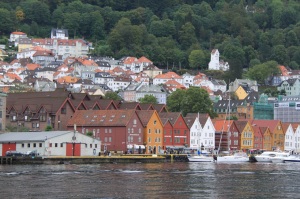 seven-hour train ride from Oslo. Bergen is a charmer most famous for Bryggen, a UNESCO World Heritage site of colourfully painted wooden Hanseatic buildings on the quay side. It’s easy to amble around and we have managed to see the unique pen and ink version of Edvard Munch’s The Scream at the impressive KODE museum as well as lunch at the water-edge fish market.
seven-hour train ride from Oslo. Bergen is a charmer most famous for Bryggen, a UNESCO World Heritage site of colourfully painted wooden Hanseatic buildings on the quay side. It’s easy to amble around and we have managed to see the unique pen and ink version of Edvard Munch’s The Scream at the impressive KODE museum as well as lunch at the water-edge fish market.
MS Nordkapp calls in at more than 30 coastal towns, the majority within the Arctic Circle, and sometimes as many as eight in a day. We sleep through several during brief middle-of-the-night dockings. But each day there are a number of major stops with onshore excursions, which vary according to the season. A few passengers seem never to move from the comfort of the expansive observation lounge, but we have signed up for pretty much everything.
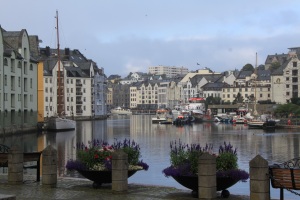 On our first full day after crossing the Stadthavet, one of many stretches of sea, we sail into the Hjorundfjord, 33km long, and moor at the tiny town of Urke. We think it could not get more beautiful. In the afternoon, we dock in the centre of pretty little Alesund and wander past colourful wooden canal warehouses and elegant art-nouveau buildings. Next morning, by the time we have finished breakfast, we are arriving in Trondheim, Norway’s third-largest city, founded more than 1100 years ago by the Viking king Olav Tryggvason. We have a morning to explore, and the standout is its mighty gothic-style cathedral.
On our first full day after crossing the Stadthavet, one of many stretches of sea, we sail into the Hjorundfjord, 33km long, and moor at the tiny town of Urke. We think it could not get more beautiful. In the afternoon, we dock in the centre of pretty little Alesund and wander past colourful wooden canal warehouses and elegant art-nouveau buildings. Next morning, by the time we have finished breakfast, we are arriving in Trondheim, Norway’s third-largest city, founded more than 1100 years ago by the Viking king Olav Tryggvason. We have a morning to explore, and the standout is its mighty gothic-style cathedral.
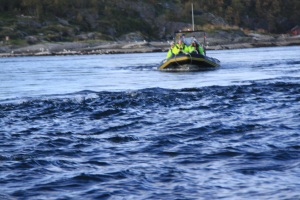 Two hours after leaving, we pass Kjeungskjaer Fyr, the eye-catching octagonal lighthouse that is switched off as the Midnight Sun takes over illumination duties, and marvel as we pass through the narrow Stokksundet with its curious 90-degree bend. In Bodo, we go on a sea safari, decked out like a
Two hours after leaving, we pass Kjeungskjaer Fyr, the eye-catching octagonal lighthouse that is switched off as the Midnight Sun takes over illumination duties, and marvel as we pass through the narrow Stokksundet with its curious 90-degree bend. In Bodo, we go on a sea safari, decked out like a
 special-ops team, and ride full pelt to the Saltstraumen, a narrow channel linking the Saltfjorden and Skjerstadfjorden, which has the strongest tidal current in the world. Even on the calmest of days it looks black and menacing. On the way back we are buzzed by a sea eagle then see half a dozen more, silent sentries watching from clifftops. In the evening, we join a family of Vikings for dinner, ending with a singsong rather than a raiding party. History didn’t used to be this much fun.
special-ops team, and ride full pelt to the Saltstraumen, a narrow channel linking the Saltfjorden and Skjerstadfjorden, which has the strongest tidal current in the world. Even on the calmest of days it looks black and menacing. On the way back we are buzzed by a sea eagle then see half a dozen more, silent sentries watching from clifftops. In the evening, we join a family of Vikings for dinner, ending with a singsong rather than a raiding party. History didn’t used to be this much fun.
Some sights are part of modern Norway, such as the Arctic Cathedral in  Tromso, its shape reflecting the frames used to dry fish, and regularly used for concerts. Trondenes Church, the northernmost medieval building that dominates the windswept promontory at Harstad, exists between the old and the new. Solid and unadorned, it is a still-functioning fortress for God, but for many years it was also an important place of resistance against Russian invaders. Inside it is peaceful and exquisitely decorated, with three beautiful triptychs to the Virgin Mary.
Tromso, its shape reflecting the frames used to dry fish, and regularly used for concerts. Trondenes Church, the northernmost medieval building that dominates the windswept promontory at Harstad, exists between the old and the new. Solid and unadorned, it is a still-functioning fortress for God, but for many years it was also an important place of resistance against Russian invaders. Inside it is peaceful and exquisitely decorated, with three beautiful triptychs to the Virgin Mary.
 We breakfast at North Cape, the northernmost point in Europe, shrouded in a dense fog that somehow makes it more dramatic than if we could see the abyss beyond. Then we return to the ship past herds of reindeer, which spend the summer months in the north before the still-nomadic Sami families move with them down to the (slightly) warmer pastures for the winter.
We breakfast at North Cape, the northernmost point in Europe, shrouded in a dense fog that somehow makes it more dramatic than if we could see the abyss beyond. Then we return to the ship past herds of reindeer, which spend the summer months in the north before the still-nomadic Sami families move with them down to the (slightly) warmer pastures for the winter.
This is not a voyage where onboard entertainment is necessary or 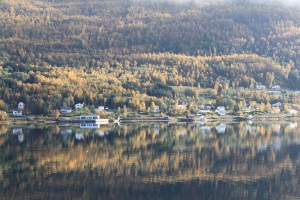
wanted. Staring at the scenery is virtually a full-time job: the subtle differences in the way the water moves; the seemingly unending palette of colours that makes up the sunrises and sunsets; the patchwork congregations of wooden houses; the constellation of islands that forms the archipelagos we silently weave through. We marvel at how even the most rugged mountainside or inhospitable outcrop has a lone cottage.
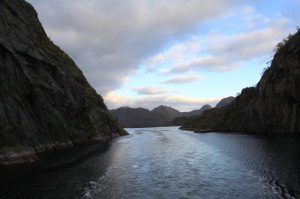 We visit places that are part of legend, such as Trollfjord in the Lofoten Islands, a dead-end inlet where in 1890 a fierce battle between rival fishermen was fought. The towering, sheer cliffs feels close enough to touch, but the captain still manages to take MS Nordkapp into an immaculate 180-degree turn. Then there’s Kirkenes, a tiny village just a few kilometres from the Pasvikelva River, which marks the border with Russia. We drive quad-bikes through forests that are decked out in a jeweller’s display of yellows and orange to the chain-link fence that marks the border with Russia. Quiet now, but in World War II it was a battle frontline, with only 13 houses surviving.
We visit places that are part of legend, such as Trollfjord in the Lofoten Islands, a dead-end inlet where in 1890 a fierce battle between rival fishermen was fought. The towering, sheer cliffs feels close enough to touch, but the captain still manages to take MS Nordkapp into an immaculate 180-degree turn. Then there’s Kirkenes, a tiny village just a few kilometres from the Pasvikelva River, which marks the border with Russia. We drive quad-bikes through forests that are decked out in a jeweller’s display of yellows and orange to the chain-link fence that marks the border with Russia. Quiet now, but in World War II it was a battle frontline, with only 13 houses surviving.
After Kirkenes, MS Nordkapp turns around and heads south again,  alternating its schedule of stops to allow for exploration of towns missed out when heading north. The passengers are constantly changing, mixing and matching the length of travel that best suits. A few disembark at Kirkenes and head for Russia. More get off at Trondheim for an extra day in this impressive city before returning to Oslo. As they leave, new passengers join. It makes for a lively social swirl.
alternating its schedule of stops to allow for exploration of towns missed out when heading north. The passengers are constantly changing, mixing and matching the length of travel that best suits. A few disembark at Kirkenes and head for Russia. More get off at Trondheim for an extra day in this impressive city before returning to Oslo. As they leave, new passengers join. It makes for a lively social swirl.
MS Nordkapp, which celebrates its 20th birthday next year, is far from the poshest of ships, but it doesn’t aim to be. The cabins are basic, but have everything you could need, including good storage. There is one restaurant and one cafe for the few passengers who aren’t on full board, and for the locals using Nordkapp as public transport. The bar is friendly, but not raucous.
The food is all-you-can eat smorgasbord at breakfast and lunch, and a fixed menu in the evening. The freshest of local produce is added to the menu as the ship makes its way along the coast. Only hours after visiting Skarsvag — the tiny community that is Europe’s northernmost fishing village and where hundreds of kilos of king crab go straight from ocean to crate for live export by air to China and South Korea — we are enjoying the sweetest of crab salad on MS Nordkapp. As we eat, we toast our unforgettable trip.
Checklist: As well as cruises up the Norwegian coast, Hurtigruten offers voyages to Spitsbergen, Greenland, Iceland and Antarctica. In 2016, itineraries will offer more “active” land-based excursions, including mountain biking. More: hurtigruten.com.








Comments
Looks great! Beautiful pictures!